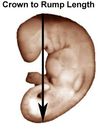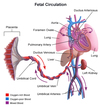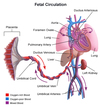7: Foetal Growth & Development Flashcards
(71 cards)
When is the foetal period?
From: end of week 8
To: birth
What are the 3 processes of the foetal period?
- Rapid growth (increased cell size + number)
- Continued tissue + organ differentiation
- Relative slow down in growth of head compared to rest of body
When is the embryonic period?
First 8 weeks
What happens in the embyronic period? (3 things)
- Morphogenesis (Crown Rump Length increases rapidly
- Growth @ placenta
- Organogenetic activity
MGO

What does foetal survival depend on in terms of the respiratory system? (2 things)
- Presence of thin-walled air sacs for gas exchange
- Presence of surfactant to reduce surface tension + allow air sac to expand
What are the 4 stages of lung maturation?
- Pseudoglandular (week 8 - 16)
- Canalicular (week 16 - 26)
- Terminal Sac (week 26 - term)
- Alveolar (late foetal - 8 years old)
Puff Cones Till Afterlife

Are the lungs viable in the pseudoglandular stage of lung maturation?
No

Are their air sac in the pseudoglandular stage of lung maturation?
No

Where are the airways formed up to in the pseudoglandular stage of lung maturation?
Ony as far as Terminal Branches

Are the lungs viable in the canalicular stage of lung maturation?
Maybe at end

What is formed in the canalicular stage of lung maturation?
Respiratory bronchioles

What happens in the terminal sac stage of lung maturation? (3 things)
- Terminal sacs bud off from respiratory bronchioles
- Cells differentiate → Type 1 & 2 Pneumocytes (allow diffusion)
- Surfactant produced

What happens in the alveolar stage of lung maturation? (late foetal - 8 years old)
95% of alveoli formed post-natally

What changes occur to the lungs at birth? (4 things)
- Lungs filled with amniotic fluid
- Most is expelled @ vaginal birth and rest is absorbed
- At first breath
- Pulmonary resistance decreases
- Alveoli open
- Blood flow increases in pulmonary vessels
What does placental progesterone promote?
Foetal corticosteroid production (vital for CVS)
When does the foetal thryoid gland begin to work?
Week 12
What do the thyroid hormones help develop? (2 things)
- Hair
- Bone
- CNS
HBC (like HSBC innit)
What does the foetal liver store?
A lot of glycogen
Reflected in changes in foetal abdominal circumference
When is the definitive heart rate acheived?
Week 15
How are heart beats heard in Week 8, Week 12, and Weeks 18 - 20?
Week 8: via Transvaginal US
Week 12: via Doppler Stethoscope
Weeks 18 - 20: via Plain Stethoscope
What is the heart beat at week 8 (measured by transvaginal US) used for?
To rule out ectopic pregnancy
What is the average heart beat at term?
140 - 160 bpm
When is the kidney finished ascending and ready to function?
Week 10
What happens to the kidney at week 10?
Becomes a major contributor to amniotic fluid











